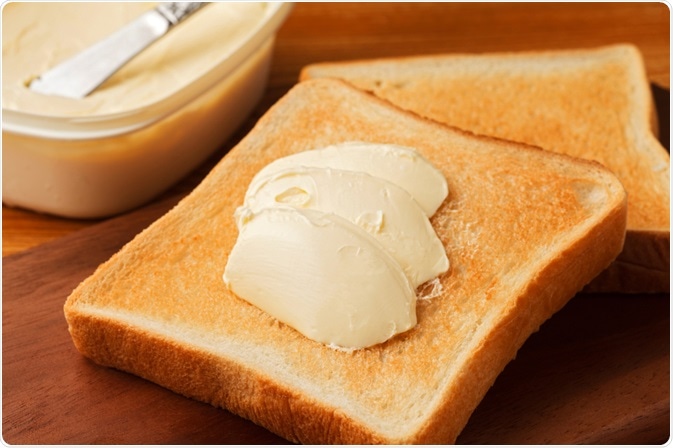Trans fat is produced in a chemical reaction of hydrogenation that was first discovered at the end of the nineteenth century and became more widely used over the following years. More recently, health concerns associated with the consumption of trans fat have become evident, prompting food manufacturers to reformulate products that contain trans fat.

Image Credit: sasazawa / Shutterstock.com
Development of hydrogenated fat
Paul Sabatier was a scientist who investigated chemical reactions of hydrogenation to create the fats that form the base of products such as margarine. He focused primarily on the hydrogenation of vapors but was the first to record the process to create fats that are now known as trans fats.
This concept was built upon by Wilhelm Normall, who was a German chemist who showed that liquid oils could be hydrogenated to change their physical properties. He patented the process in 1902 and went on to build the Herford Company that produced hardened fats. Joseph Crasfield & Sons Ltd expanded the process to a large-scale production plant in England and commenced production of hydrogenated fats in 1909.
At this time, Procter & Gamble acquired patent rights in the United States and released the first hydrogenated shortening product, Crisco, in 1911. This product was created from cottonseed oil that had undergone hydrogenation to become semi-solid at room temperature. It made a markedly successful entry into the market with the introduction of free cookbooks that included recipes that uniformly required Crisco as an ingredient.
Promotion of hydrogenated fats
Hydrogenated fats were well recognized for the unique properties that made their use more convenient, such as the immediate spreading of margarine after removal from the refrigerator in comparison to the hardness of butter. This was used as a promotional point for marketing campaigns, as well as superior properties for use in baking compared to lard.
A gradual trend of preference for hydrogenated fat products was in the swing in 1920 across many food industries including those that baked bread, pies and, cakes. This continued until the 1960s, with processed vegetable fats becoming increasingly more popular than animal fats. This was in part due to the low cost of production and purchase, but also as there were believed to be health benefits associated with unsaturated fats.
Safety concerns of trans fat
The first evidence of concern about the safety of trans fat present in hydrogenated fat emerged in the 1980s, which suggested an increased risk of coronary heart disease.
This led to further research on the subject and an estimate from 1994 which indicated that the consumption of trans fat was likely to cause 30,000 deaths each year in the United States alone. Health activists have since largely condemned trans fat and government regulations have been introduced to minimize the production of trans fat.
What Are Trans Fats & Why Are They Bad?
Food industries were greatly affected by these changes and public demands for healthier fats in food products. Many manufacturers, including the original U.S. product Crisco by Procter & Gamble, needed to reformulate their production process. A website BanTransFat.com was involved in a lawsuit against Kraft for the content of trans fat in Oreo cookies, which was eventually withdrawn due to promises by the company that changes would be made.
Additionally, major food chains were required to alter the fats used in their cooking processes to minimize the use of trans fats. Kentucky Fried Chicken (KFC) was also involved in a lawsuit that prompted them to substitute trans fats in their cooking process for healthier options. Other chains, including Burger King, McDonald’s, Taco Bell, and Wendy’s, also made changes to the way in which their food products were prepared.
References
Further Reading
Last Updated: Feb 23, 2023